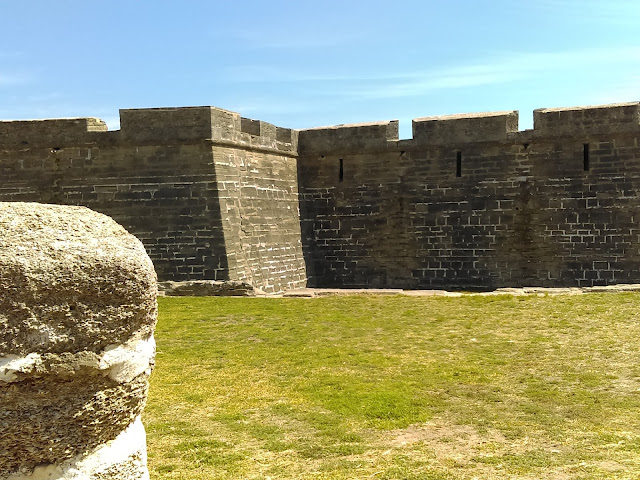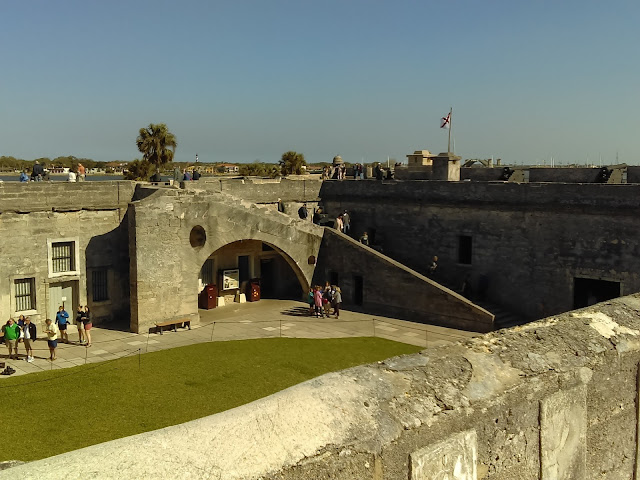Florida - part 3
(Sightseeing)
March 16, 2018 - March 22, 2018
Loved St. Augustine. Lots of interesting history here.
Government House Museum - a great place to learn the history of St. Augustine.
Florida's original native tribes.
Side note: Juan Ponce de Leon traveled with Columbus on his 2nd voyage to the "new world."
Menendez established the first settlement which became St. Augustine.
France's Fort Caroline was located where present day Jacksonville is today.
It's always about the riches that might be found.
The Fountain of Youth Archaeological Park
Laura and Juan Ponce de Leon
The spring Juan Ponce de Leon found when he landed in 1513 - still running today.
Nothing much was said about the search for the "fountain of youth" aspect of Ponce de Leon's voyage. More likely the water was important because they needed to restock the supply on their ship.
Representation of Timucuan village life.
Native dugout canoe.
By chipping and burning the wood they eventually achieved the shape they desired.
Old anchor and canon.
This large fire baked clay pot weighs about 1000 lbs and is over 300 years old.
A tinajones is a Spanish water urn used to catch rain water.
I found this interesting! Proof there have always been scoundrels.
The old Alcazar Hotel - now the location of the Lightner Museum. They have fabulous collections of glass, ceramics, furniture, handiwork and eclectic collections.
Interior courtyard of the old hotel.
Exquisite tile floor in the entrance to the Museum.
Above and below - looking down on the main floor of two of the galleries.
One half of an incredible collection cut crystal glass.
Beautiful art glass.
Bohemian glass.
Royal Satin Porcelain from England
Belleek Porcelain from Ireland.
Burmese balloon back sofa made of pierced and carved wood!
Very detailed inlaid table
Examples of crochet handwork.
Sampler from 1867
Match box label collection
Part of their musical instrument collection.
Match safe collection
Collection of lighting devices
Floral wreath made of shells and paper
Button collection and button art.
"All finite things reveal infinitude" from "The Far Field" by Theodore Roethka.
All the letters in this picture are from the wing patterns of butterflies and moths.
Late afternoon at the beach.
A rare selfie!
Barney loves the beach.
Sunset on the eastern shore of Anastasia Island.
The Gonzalez-Alvarez House (the "oldest" house in St. Augustine) - built sometime after the city was burned to the ground in 1702.
Coquina stone used in a private residence.
The original house was one story.
British occupants added the second story sometime between 1765 and 1784.
One of the two rooms of the original home.
The second of the two rooms of the original home.
Storeroom built on to the original home.
Water filter. Dirty water from the top seeps through the limestone block and clean water drips into the catch basin. I wish I could remember the name of this and the country it was from. The water in the top bowl was filthy. The water in the bottom bowl was crystal clear.
Main room of the upper floor added during British rule.
Dining area of the upper floor.
Bedroom of the upper floor.
The Ponce de Leon Hotel - now Flagler College
Only the very rich could afford to vacation here. They would come for the "season" (i.e. November to Easter) at a cost of about $9,000 which included everything. That is roughly the equivalent of $250,000 in today's money!
Imagine going to college here! The hotel rooms are used as dorm rooms.
Fountain in the front courtyard.
The carved wood, plaster details and paintings all over the building are just amazing.
Tiffany glass was installed in every window of the enormous dining room.
The glass is said to be worth in the neighborhood of 6 million dollars.
This was the ladies lounge in the original hotel. It's now used for special lectures.
Detail of the clock and mantel over the fireplace.
Part of the ladies lounge.
The Fort - Castillo de San Marcos
Model of the fort. The design allowed every angle to be covered by canon fire.
Painting of how the fort was built. The domed units were called casemates.
Exterior of the fort.
Looking at the moat which did not contain water.
Inside one of the casemates looking out to the yard.
The British added a second level in the casemates in order to house more people and/or equipment.
The coquina walls were plastered over to make the walls smooth.
Casemate used for soldier's quarters.
Casemate used for storage.
Steps up to the upper level where the canons were located.
Top of the fort looking down onto the yard.
Canon's surrounded the entire top level.
Castillo San Marco was never taken in battle.
It changed hands only when different countries took control of Florida.













































































































